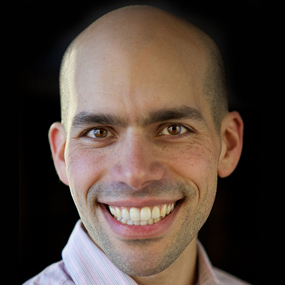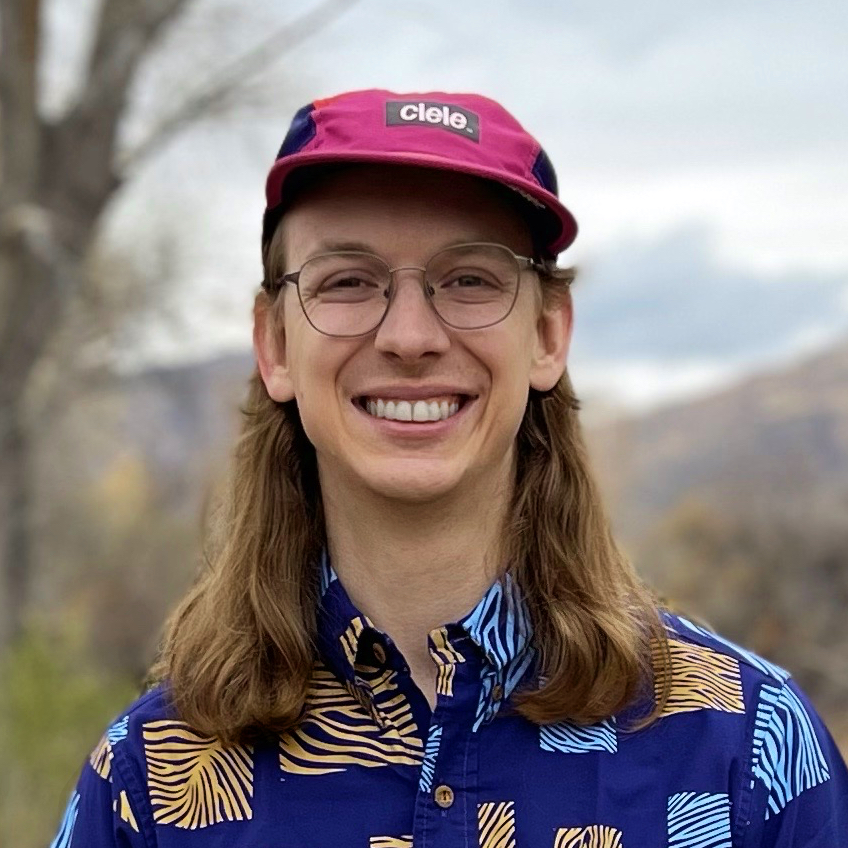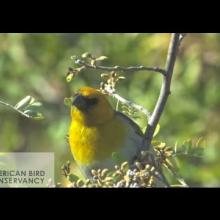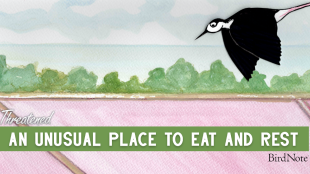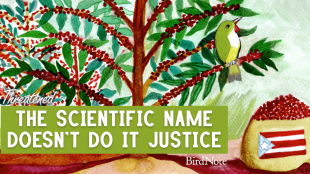

Join BirdNote tomorrow, November 30th!
Illustrator David Sibley and actor H. Jon Benjamin will face off in the bird illustration battle of the century during BirdNote's Year-end Celebration and Auction!
Ari Daniel: BirdNote Presents.
[Echoing Wingflaps SFX]
[Forest ambience from the Hakalau forest; sound of walking]
Jessie Eden: I’m walking through this high elevation forest in Hawai‘i … surrounded by birdsong that you can’t hear anywhere else on the planet.
And I’m looking at trees that are totally unique to this part of the world … some with bright red pompom flowers, others stretching nearly a hundred feet upward, with reddish golden bark, tree ferns all around. The incredible lushness of all these shades of green.
There’s this mele that I just can’t get out of my head… It's an Hawaiian chant from many years ago, filled with images of abundance and reverence for the forest and the birds. It would have been sung by someone preparing to enter a forest just like this one... Noah Gomes shared it with me the other day.
Noah Gomes (singing):
E kū hoʻohei ʻia ka manu
i ka puapua ʻeuʻeu
i kaʻu kia ʻelekeʻi
A pili kaʻu manu
i ke kēpau ʻulu,
ʻakokoko,
a māmane.
[Footsteps fade out, forest sounds gradually fade]
[Reflective Threatened theme begins]
Ari Daniel: I’m Ari Daniel and this is Threatened. In this season, we’re meeting birds that inhabit islands— specifically, the islands that make up Hawai’i. Islands are a microcosm of the broader challenges facing the planet… They are ecologically distinct places but also uniquely vulnerable. We’re starting with a group of birds that are only found in Hawai’i - the honeycreepers.
And to kick this season off, I’m here with field biologist and producer Jessie Eden, listening together to the mele from Noah.
Noah Gomes (singing): Ulu ka ʻioʻio i ka puka o ko kāua hale
[Threatened theme fades out]
Ari Daniel: Hey there, Jessie.
Jessie Eden: Hey Ari!
Ari Daniel: Can you tell me about Noah?
Jessie Eden: Noah is an educator and researcher with a life-long love of birds and a passion for his Hawaiian culture and language. He’s Native Hawaiian, or kanaka maoli.
We’re going to use a lot of Hawaiian words throughout this season. Unlike in much of the United States, many original names for the endemic plants and animals here didn’t get erased in common usage and replaced with English names.
Ari Daniel: The Hawaiian bird names, a lot of the time, they sound like the birds’ call or song.
Jessie Eden: Yeah, it's really intuitive. Kanaka maoli have a special relationship with the birds of Hawai’i… something Noah has researched:
Noah Gomes: A lot of them appear in our stories and our mele, our chants…There's symbolic meaning. The birds have meaning to particular families because their ancestors can come back as ‘aumakua, taking the form of those birds…
Jessie Eden: There’s a phenomenal amount of unique bird life here in Hawai‘i that a lot of people are totally unaware of – even many folks that live here aren’t in touch with some of this amazing beauty. And that’s because the special native bird species in Hawai‘i are becoming rarer - so now fewer people than ever get to experience them.
Noah Gomes: Every time, something like that disappears, every time we lose a plant, every time we lose an invertebrate, every time we lose a bird, every time we lose the land in some form or another, I think there is an incremental loss to the Hawaiian people. We need to value the ecosystems. The plants, the animals, the what have you - the wind, the rain, everything that has made us what we are. And we have an obligation to steward that, to keep that as a part of our lives.
Jessie Eden: Noah and a lot of other people are working hard in Hawai‘i every day to do exactly that— to make Hawaii’s birds a part of our lives. And the first step is learning more about them.
Ari Daniel: Alright, let’s go, Jessie. Where are we heading today to do that?
[Sounds of Hawaiian forests fade in]
Jessie Eden: Today we’re visiting the tallest mountain in the Hawaiian Islands— it’s called Mauna Kea. And it’s on Hawai‘i Island, the Big Island. We’re starting here because one bird family that calls Mauna Kea home is iconic of Hawaii— they’re called the honeycreepers.
Colleen Cole is program manager for Three Mountain Alliance, an organization that works to protect Hawai‘i Island’s precious forests.
Colleen Cole: The story of, especially the adaptive radiation of honeycreepers is the one that should blow everybody away.
Jessie Eden: Adaptive radiation is when a single species spreads out across an isolated region… and then, as it finds unique niches in the environment, that single species evolves into numerous species. Which is exactly what happened with the honeycreepers.
Colleen Cole: A small flock of some kind of Eurasian finch found their way to these emerging islands in the middle of the vast Pacific - blown way off course, from somewhere, for some reason, the small flock of finches found their way here and they stayed here. And this is one species that radiated into dozens of species and they filled every niche available.
Ari Daniel: So I remember from Bio class, Jessie, that Darwin saw the same evolutionary process play out on the Galapagos Islands, but clearly it didn't just happen there.
Jessie Eden: Yes, exactly – while the Galapagos finches were a great case study for Darwin, with almost 20 species from one, the islands of Hawai‘i are an even more striking example of adaptive radiation. That one species of finch, over millions of years, evolved into over fifty-five.
[‘I‘iwi songs and calls; it sounds metallic and otherworldly]
… but over half of the honeycreepers have gone extinct… 6 were declared extinct just this past year…
Colleen Cole: and the fact that we've lost most of them, they'll never be seen again in any place or time - ever. Forever -- lost to the ages.
[Meditative, slightly tense string music enters]
Jessie Eden: So much loss. But we know that we have to focus on the birds that remain. There are 17 honeycreeper species still here… over half of them endangered. And to save them, we have to restore our forests, and some semblance of ecosystem health. These native birds are fully dependent on the plants, flowers and trees and insects that they adapted with here in the islands. And many plants and trees are fully dependent on the birds for things like pollination and seed dispersal… Hawai‘i is their only home.
Ari Daniel: And I’ve been learning that over recent centuries people have had a big, and devastating, impact on Hawaiian ecosystems. All the large-scale agriculture, intensive ranching, logging – and introduced critters and diseases from elsewhere in the world – that it’s all contributing to scarring Hawaii’s forests.
Jessie Eden: It has. And a lot of people are surprised to learn that the only terrestrial mammal native to Hawai‘i is a single bat species – all the other land mammals that you see here were introduced by humans. Changes to the islands’ ecology have happened so fast. The native birds here haven’t had time to adjust to these changes – and they don’t have anywhere else to go.
Ari Daniel: We’re going to take a quick break, and when we return Jessie digs into the story of one kind of honeycreeper, its courtroom drama, and what happens when we come together to protect it. Stick around.
[String music fades out]
[MIDROLL AD BREAK]
[Palila singing; it’s bouncy, and sounds almost jovial]
Jessie Eden: There’s one honeycreeper species in particular who is an example of how intertwined the birds are to their place. It’s the critically endangered Palila.
Colleen Cole: They're so cute. They're kind of fluffy. They've got the most gorgeous, like daffodil yellow, black mask, and then the most elegant dove gray. And so they're striking.
Ari Daniel: Jessie, was that Colleen the Three Mountain Alliance Program Coordinator?
Jessie Eden: Yeah but that’s not her only title — She's also been called the Palila queen by her bird survey colleagues. That’s because when she does the surveys… she often counts more palila than anybody else.
Colleen Cole: When you spend a lot of time in their habitat, you hear them almost like talking to each other… it reminds you of somebody sort of humming to themselves.
Jessie Eden: Palila used to be widespread in the Islands, thriving on Kaua'i, ‘Oahu, and the Big Island. But, these days…
Colleen Cole: They’re only found on one side of one mountain on one island, in the middle of the Pacific – so, yeah, they’re a very vulnerable population.
[Bouncy synth music begins]
Jessie Eden: Palila survive on a tiny stretch of forest on Mauna Kea’s southwest flank. Remember, Mauna Kea is the tallest mountain in the Hawaiian islands, so it’s high elevation. The lower elevations of the Hawaiian Islands have been transformed by land use practices that fragmented or destroyed forests. Palila had to follow their habitat… which meant moving to higher and higher ground.
Colleen Cole: A lot of that land use, especially on Mauna Kea, there was a lot of grazing there. And so their habitat got smaller and smaller. You have all this land that’s been for agriculture, sort of, below and then you have the tree line – they got more and more squeezed over time into this narrow habitat.
[Bouncy music fades out]
Jessie Eden: So now all the palila have to work with is 5 percent of their original range… that’s because it’s where their food is. Remember how we talked about adaptive radiation?
Ari Daniel: Yeah, how when those Eurasian finches landed in Hawai’i they evolved into a bunch of different species?
Jessie Eden: Exactly. Well, some birds began to eat nectar, some ate insects – the Palila specialized on seeds.
[Palila song in the background]
Colleen Cole: …they're found a lot of times in māmane trees, right? Which are known for their beautiful blossoms. And they're this gorgeous deep, golden yellow. So they just look like they're made to co-exist with māmane.
Jessie Eden: Palila adapted with the māmane tree over many years, evolving a short pointy beak, perfectly suited to breaking into the māmane’s green seed pods.
[Sounds of the forest near Paul Banko’s home; there’s a light breeze, and many birds are singing in the distance]
Paul Banko: Actually opening a pod for a small bird is a tough thing.
Jessie Eden: Wildlife Biologist Paul Banko has spent a lot of his career studying Palila.
Paul Banko: And if you watch Palila pulling these pods open, they're opening hundreds of pods in the course of a day, you got to figure, man, their necks must be just so sore at the end of the day because they use a lot of strength. You won't find any lazy birds in Hawaiian forests because it's just too hard to make a living.
You see for about three to four months, parents demonstrating techniques for ripping open the pods, the youngsters making kind of bumbling attempts to do that at first, you know – the parents still having to feed them.
These kūpuna, if you will, keep many populations going.
Jessie Eden: Kupuna is Hawaiian for elder, the revered older generation – these kūpuna birds, as Paul puts it, have always mentored that next generation - teaching vital survival skills to their young.
Palila cannot exist without māmane trees. And so as the forest declined, so did the Palila – and in 1967, they were listed as endangered, one of the first species in the U.S. to receive that designation. Twelve years later, a landmark case was brought on behalf of these birds. Palila vs. the Hawai‘i Department of Land and Natural Resources.
[Law & Order “Dun Dun” sound; Tense, curious keyboard music enters]
The lawsuit was against the state agency because they weren’t protecting this endangered bird’s habitat.
Ari Daniel: So Jessie, this was different from other lawsuits that said you just had to protect the animal.
Jessie Eden: Exactly, they argued habitat is vital to the well-being and survival of a species. And, this is kind of wild — when this went to court, the plaintiff made an appearance.
Ari Daniel: What— the bird was there??
Jessie Eden: Yeah. They brought a stuffed Palila from a Hawaiian museum into the courtroom. The judge examined it – and it remained there throughout the proceedings.
Ari Daniel: I love that.
[Tense keyboard music fades out]
Ari Daniel: So Jessie, how did the lawsuit unfold?
Jessie Eden: Ultimately, the ruling was in favor of Palila. They said the damage to their habitat had to stop. This was a pivotal decision— it’s been used as precedent in other cases like that of the spotted owl in Pacific Northwest forests.
Ari Daniel: Should we consider that kind of a success story for these birds?
Jessie Eden: Oh, man, we wish. The court ruled that the sheep and other grazers had to be removed. And many of them have …but not all – And a fence to keep them out still hasn’t been fully completed. Some sheep still remain right there in Palila habitat.
Ari Daniel: Wait. Over 40 years after that initial court ruling, and the state’s still trying to get those sheep outta there? It sounds like these delays would have been devastating for Palila.
Jessie Eden: Yeah, the palila have been struggling. And you know what, Ari? We haven't even talked about the introduced feral cats that sometimes eat Palila.
Ari Daniel: Oh boy.
Jessie Eden:Yeah, so on top of the habitat destruction, introduced predators are another challenge to Palila - and the other forest birds of course. Hiking through the Palila’s mamane forest one morning, I was hoping to hear at least one bird singing… but I actually got to hear two!
At last survey, the Palila population was down to several hundred birds - so I got really lucky to hear them at all. But folks like Alex Wang say there’s hope.
Alex Wang: I think this is a saveable species, frankly.
Jessie Eden: Alex is a wildlife biologist with the Division of Forestry and Wildlife. He says the fate of this entire species could be as simple as putting up a fence that would keep sheep and predators out.
Alex Wang:Palila country up here, it’d be a perfect place to build a predator proof fence that’ll keep out cats, mongoose and rats. And then if we put that where Palila are breeding, I think they have a good chance to rebound
Ari Daniel: OK, so maybe this is a dumb question, but… these fences keep cattle and sheep out, sure, mongoose, rats, OK, but cats — how is that working exactly?
Jessie Eden: That’s not a dumb question at all — its basically a fence that you know obviously they can’t fit through. And then at the top of it, there’s some sort of overhang so that the cats can’t effectively climb over it, you know they would be going upside down and trying to wrap themselves around the upper part of the fence.
Ari Daniel: And I guess the fences are either far enough away from trees or tall enough that they aren’t going to be able to jump over?
Jessie Eden: Right — and Alex here has a lot of experience with fences and how big a difference they can make for conservation. He often works in an area with effective fences protecting habitat from grazers. It’s just on the other side of Mauna Kea…
[Sounds of a car traveling across Mauna Kea; an engine rumbling, sound of bumping over rough ground]
Jessie Eden: It’s about a two hour drive over some rough terrain by car, about ten miles away as the birds fly .. but it’s a world of difference for the honeycreepers that live there.
[Car sounds fade into sounds of the forest; it’s lush, filled with birdsong]
Alex Wang: This area was grazed by cattle. So it was really roughed up. But, there's no longer cattle in here. We’re not ranching it. Could it do better? Yeah, but I'd still say it's a success.
Jessie Eden: This area is called Hakalau Forest National Wildlife Refuge. It’s surrounded by fences – plenty of gates to pass through as you enter the rainforest.
Alex Wang: The canopy trees are growing back. Hakalau you can observe in satellite imagery - it's just been an amazing transition of these canopy trees. It’s been a major restoration site for a long time and it's a high elevation, so it's got some of the highest densities of our endangered birds.
Jessie Eden: When I hikedthrough Palila country, I’d heard two of them singing. And felt like I’d won the lottery. But here, in this restored lush Hakalau forest, when the wind stopped rustling the trees, my ears were filled with birdsong.
Alex Wang: I don't know if you've been seeing or hearing this morning, but there's tons of ‘Akepa here, which is, um, fantastic to see…
Jessie Eden: ‘Akepa are one of six species of honeycreepers that can be found in Hakalau.
Alex Wang:The ‘Akepa is gorgeous. It's like blaze orange and it's just so vibrant. It's like, it's like a traffic sign
Alex Wang:…Over there you can see, even from far away, there's a bright red ‘I’iwi. There it goes, being chased by another young ‘I’iwi.
[‘I‘wi call]
Alex Wang: That's the ‘I’iwi with that kind of raspy metallic sounding.
[‘Amakihi call]
Alex Wang: So that's the ‘Amakihi, but there's a one that kind of sounds similar to that, the ‘Alawi here. They were singing this morning where it's a trill as well, but it has a long overall descending arch
Jessie Eden: and the ‘Alawi is the one that Noah Gomes helped name. Is that correct?
Alex Wang:Yeah. Yep. It’s the one he helped kind of rediscover its forgotten Hawaiian name - and so yeah, we had a whole naming ceremony and it was great that we were able to bring the name ‘Alawi back.
[Curious marimba and pizzicato string music begins]
Jessie Eden: Noah’s the researcher and cultural practitioner who we met earlier.
Noah Gomes: I was doing a lot of research in the Hawai‘i state archives..and I got lucky and came across a bunch of material regarding birds and bird catching that had gone overlooked.
Jessie Eden: Noah kept finding accounts mentioning a bird called the ‘Alawi – and he realized it fit the description of a bird we’ve been calling the Hawai‘i creeper. Nobody knew its original name. So Noah shared this research with Alex and other colleagues…and now, people are able to use this bird’s appropriate Hawaiian name again.
Noah Gomes: Names are power, right? You know something’s name, you have a degree of familiarity with it, you have a relationship you’re building with it. Knowing the name for this bird is ‘Alawi connects us where suddenly it’s relevant to all kinds of things in our past that we didn’t know about. It’s particularly important for Native peoples who have experienced loss of their language, um, because there are so many things encoded in that.
[Curious music has faded out]
Jessie Eden: Partnerships between cultural practitioners and biologists are vital to finding a way forward. Native Hawaiians, or kanaka maoli, developed intimate knowledge of the inner workings of forest ecosystems and honeycreepers – and how to be a part of those relationships.
Noah Gomes:Everything is just really connected -- in a lot of different ways -- within the Indigenous world, within the science world. There are things that we can learn from the Indigenous way of thinking. Not just living, but the way of thinking – and the perspectives that are involved with that that can inform our practices today.
Jessie Eden: The sharing of knowledge is increasing throughout Hawaii; It’s essential for healing this place, connecting our communities and saving our birds…
It’s something more and more biologists, like Pat Hart, are recognizing and incorporating into their practices.
[Sounds of the Hakalau forest fade up; it’s lush and filled with birdsong. Leaves and branches crunch under Pat and Jessie’s feet]
Pat Hart: So when we enter the forest, just to put you like in the right frame of mind to enter the forest. Hawaiians, feel best if they ask for permission before they enter a place.
Jessie Eden: On this particular day, I had joined Pat as he was heading out along a trail in the Hakalau Forest. But before we got to work, Pat recited a mele that was written by a friend and colleague of his.
Pat Hart: The place is offering you something. And so what can you offer the place? And so in this, you offer your breath is the idea.
I say “ʻO wai ka mauna?”
And you say “ʻO Maunakea ka mauna”
“ʻO wai ka moku?”
“ʻO Hilo ka moku”
“ʻO wai ke ahupuaʻa?”
“‘O Hakalau ke ahupuaʻa?”
And I say “I aha ai kou hiki ʻana mai?”
… for what reason do we come?
“I komo, i komo aku au i o kahiko mā”
Which is, we are entering to learn from the ancient ones. I'm probably missing a little bit of the translation there.
He aloha ē, he aloha!”
Hoe! ‘Ō, ō, ōia!”
And then you breathe in, breathe out and then you're done.
[Hakalau forest birdsong for a few seconds]
Jessie Eden: Hawaii’s honeycreepers evolved with this unique part of the world, developing special relationships with their forest homes; it’s all connected. And it’s the same with us. Our own fate is tied to the health of these ecosystems, just as it is for the birds.
Pat Hart: In my mind, in 10 years, given the political will, my goal is for humans to be able to live around native birds again, like we used to - and let them be part of our lives.
Jessie Eden: And people like Alex feel a real sense of responsibility to take care of their home.
Alex Wang: I think it's our kuleana or responsibility. I mean, we live here. These things were here long before us, long before us, and they are going extinct because of us and it's preventable - and we know what we need to do it will cost money, yes. It will take effort. I think that’s important.
Jessie Eden: Yeah, you are a dedicated, passionate bunch. That is for sure.
Alex Wang:I mean, I love these birds, so, um, I dunno. I don't, I don't get depressed and not do things — I try to do all the things to save them.
Jessie Eden: And Noah agrees.
[Reflective Threatened theme music by Ian Coss starts to slowly fade up]
Noah Gomes: Having responsibility, as we say, among Hawaiians is, is an honor. Um, kuleana is an honor to have.
[Theme music soloed for a few seconds]
Ari Daniel: In addition to the habitat destruction and invasive species that Jessie told us about in this episode, honeycreepers are up against another big threat - mosquitoes that transmit a deadly disease. But, there’s hope on the horizon.
Dennis LaPointe: This is the first tool that’s come along that doesn’t send up red flags everywhere. So I’m cautiously optimistic.
Ari Daniel: But will it come in time for the honeycreepers? That’s next week on Threatened.
This episode was produced by Jessie Eden and me, Ari Daniel. It was edited by Caitlin Pierce of the Rough Cut Collective. Audio mix by Sam Johnson and Mark Bramhill. Fact-checking by Conor Gearin. Our theme song and original music were composed by Ian Coss, with additional music by Blue Dot Sessions. Threatened is a production of BirdNote and overseen by Content Director Allison Wilson. You can find a transcript of this show and additional resources, BirdNote’s other podcasts, and much more at BirdNote dot org. Thanks for listening. See you next time.
[Theme music ends]
######################
SFX:
Bird sounds provided by The Macaulay Library of Natural Sounds at the Cornell Lab of Ornithology, Ithaca, New York. ML236860 Palila recorded by Tim Burr.
XC127673 - Hawaii Akepa recording by Brooks Rownd; XC15736 - ‘I‘iwi recording by Roger Ahlman provided by Xeno-Canto.
Dawn chorus in the Hakalau Forest recording provided by Patrick Hart at the Listening Observatory for Hawaiian Ecosystems (LOHE) Lab from the University of Hawai‘i at Hilo.
MUSIC:
Threatened Theme by Ian Coss
“Brek PKL”, “Jubello”, “Bedroll”, and “Idle Ways (Simple Light)” by Blue Dot Sessions



